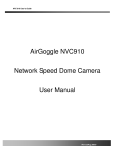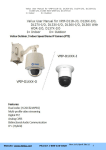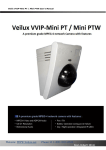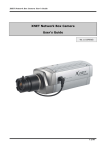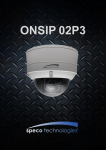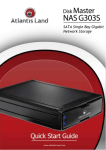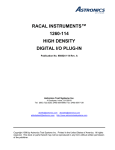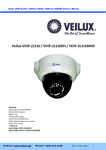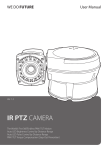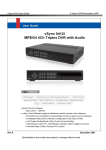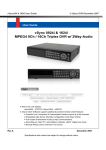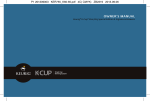Download Network Dome User's Guide Rev1.0(Dec.2006)
Transcript
Network Dome User’s Guide Rev1.0(Dec.2006) Network Dome User’s Guide Directions Network cameras are designed for outdoor/indoor use. Don’t use them in an environment that exceeds the limited range. Be careful not to cause any physical damage by dropping or throwing the network camera. Especially keep the network camera out of reach from children. Do not disassemble network camera or After Service Follow-up is not possible. Use only the AC power adapter which conforms to the specification in data sheet or optionally provided AC power adapter with the network domes. If you would like to use the Network Domes for security, monitoring, please check the legal regulations within the country. Note This equipment has been tested and found to comply with the limits for a Class A digital device, pursuant to part 15 of the FCC Rules. These limits are designed to provide reasonable protection against harmful interference in a residential installation. This equipment generate, use and can radiate radio frequency energy and, if not installed and used in accordance with the instructions, may cause harmful interference to radio communications. However, there is no guarantee that interference will not occur in a particular installation. If this equipment does cause harmful interference to radio or television reception, which can be determined by turning the equipment off and on, the user is encouraged to try to correct the interference by one or more of the following measures z Reorient or relocate the receiving antenna. z Increase the separation between the equipment and receiver. z Connect the equipment into and outlet on a circuit different from that to which the receiver is connected z Consult the dealer or an experienced radio/TV technician for help. Rev.1.0 (Dec.2006) 2 Network Dome User’s Guide Warning & Caution for Network Domes If you fail to read this information and handle the product incorrectly, death or serious injury may occur. The unit should be installed by trained personnel. Always stop using when the product emits smoke or abnormal heat. This symbol is intended to alert the user to the presence of un-insulated “dangerous voltage” within the product’s enclosure that can cause electric shock.. Never install the product in area exposed to water, oil or gas. Never install the product on a ceiling that This symbol is intended to alert the user to the presence of important operating and maintenance (servicing) instructions in the literature accompanying the appliance. cannot hold its weight. Never touch the power cord with wet hands. Clean only with dry cloth. Never install the product in extremely high or low temperature. Never drop, hit strongly nor vibrate the Additional Warning & Caution for Network Domes If you fail to read this information and handle the product incorrectly, death or serious injury may occur. Input power: 25 watts at 24V AC product. Never expose the product to direct sunlight or severe ray. With Camera - 24V AC Heater: 18watts Fan: 2watts The heater activates at +10℃ (±5℃), deactivates at +15℃(±5℃) Never touch the front glass of the product. The fan activates at +45℃ (±5℃), Deactivates at +35℃ (±5℃) Never install the product in areas exposed to rain or water Never install the product on a ceiling that cannot hold its weight. Never install the product in area exposed to water, oil or gas. Rev.1.0 (Dec.2006) 3 Network Dome User’s Guide Revision History Date Rev. No 2006-12-06 1.0 Description Creation of the document Rev.1.0 (Dec.2006) 4 Network Dome User’s Guide Table of Contents 1. Introduction ......................................................................................................................... 7 1.1. Overview ............................................................................................................................. 7 1.2. Features of Network Domes ................................................................................................ 7 1.3. Applications of Network Domes ......................................................................................... 10 2. Product Description ........................................................................................................... 11 2.1. Package Contents ............................................................................................................. 11 2.2. Preview ............................................................................................................................. 11 2.3. PC Requirements .............................................................................................................. 12 2.4. Physical description........................................................................................................... 12 2.5. Specification of the analog camera .................................................................................... 17 2.6. Quick Installation Guide ..................................................................................................... 19 3. Connecting Network Domes to IP Network ....................................................................... 22 3.1. Connecting to LAN ............................................................................................................ 22 3.2. Connecting to xDSL/Cable Modem .................................................................................... 23 4. IP-Installer ......................................................................................................................... 25 4.1. Main window of IP-Installer ................................................................................................ 25 5. Configuring Network Domes in Administrative Mode......................................................... 26 5.1. Log On .............................................................................................................................. 26 5.2. Basic Setup ....................................................................................................................... 28 5.3. Network Configuration ....................................................................................................... 30 5.4. Wireless Configuration (This is not applicable to Network Domes network camera) ............ 33 5.5. User Admin & Time Setup.................................................................................................. 35 5.6. Sensor & Capture Setup.................................................................................................... 38 5.7. Alarm Device Setup ........................................................................................................... 40 5.8. Motion Region Setup ......................................................................................................... 41 5.9. PTZ Setup......................................................................................................................... 43 5.10. Encryption Set up ............................................................................................................ 45 5.11. Upgrade & Reset ............................................................................................................. 47 5.12. Status Report .................................................................................................................. 49 6. Tips for Using Network Domes .......................................................................................... 50 6.1. Alarm (for Sensor input) and AUX(for Relay output) ........................................................... 50 6.2. Trouble Shooting ............................................................................................................... 53 6.3. Web Viewer)...................................................................................................................... 55 6.4. How to upgrade Network Domes firmware ......................................................................... 56 Rev.1.0 (Dec.2006) 5 Network Dome User’s Guide Appendix 1. On Site Installation of Network Dome Indoor Type ............................................ 58 Appendix 2. On Site Installation of Network Dome Outdoor Type ......................................... 63 Rev.1.0 (Dec.2006) 6 Network Dome User’s Guide 1. Introduction 1.1. Overview The Network Domes is a state-of-the-art Speed Dome network camera which transmits synchronized video and audio data in real time with D1 resolution at full frame rate. This is possible through MPEG4 CODEC technology, which provides high quality video with highly compressed data streams. The Network Domes can be connected, controlled and monitored from a remote location through an IP connection over internet or intranet. Unlike CCTV or DVR, the Network Domes is easy to install and owner will experience cost and space savings in the installation owing to the state of the art technologies embedded in the system. Based on Embedded Software Solution (Embedded Web Server, Embedded Streaming Server, Network Protocol), the Network Domes ensures unprecedented performance and stability to be an ideal network camera solution for system integration solutions. Network Domes is offered with standard Ethernet interface. 1.2. Features of Network Domes y 1 channel synchronized real time Video/Audio streaming MPEG-4 video, ADPCM audio. y Bi-directional audio communication Real time audio communication between Network Domes and Client PC y The viewer assisted recording and playback functions y World Most Silent Speed Dome IP Camera (Outdoor Type) y 1/4 “Sony Ex-view CCD 26x, 18x, 36x / Super HAD CCD 22x, 30x y Filter Changeable Type Day & Night y IP66 water-resistant (Outdoor type only) y 220x Zoom (22x Optical with 10x Digital zoom) Selectable - 26x/18x/36x (with 12 x digital zoom) Sony zoom camera is optional - 30x (with 10x digital zoom) is optional y Max 30 frames/sec (NTSC) and Max 25frames/sec (PAL) @ D1 resolution y Full D1 Resolution with De-interlaced filter y World Most Silent Speed Dome IP Camera (Outdoor Type) y Versatile PTZ control Client viewer assisted PTZ control, Dedicated virtual system controller for PTZ control on the client Simultaneous connection & control over IP and RS485 y 4 Alarm sensor inputs / 2 relay outputs y Motion detection – Up to 3 motion detection zones. Arbitrary shape motion detection zone Rev.1.0 (Dec.2006) 7 Network Dome User’s Guide Motion detection can initiate video recording, which is sent to the user through FTP and/or E-mail. y Resolution - NTSC: 704x480, 352x240, 176x144. - PAL/SECAM: 704x576, 352x288, 176x144 y Remote administration control Entire operational parameter set up, Software upgrade y Various Mounting Brackets Wall, Pipe, Gooseneck mounting brackets Corner mount adaptor, Pole mount adaptor y Built-in Fan / Heater Rev.1.0 (Dec.2006) 8 Network Dome User’s Guide y Detailed Features of Speed Dome part World most silent speed dome camera Hot Keys Adoption of timing belt, specialized gear, and other lownoise-technologies reduced mechanical vibration which significantly enhances durability and quality of the camera. This camera is the perfect match, both indoor and outdoor, for demanding security and monitoring applications. This camera supports various hot key functions for ease of control by other controllers or DVRs. Various Surveillance Functions Auto Scan continuously repeats movement between two preset positions with various speed and dwell time. 0.024° dome system accuracy with 1/8 micro step By adopting 1/8 micro step and twin gear system, the dome camera achieved 0.024° rotational accuracy. It provides excellent precision for delicate control such as preset positions. Reliable RAM-Material The mechanical stability achieved by using high quality materials (e.g., stepping motor, slip ring, timing belt and power condenser) improves the durability and life time of the camera. The camera housing is made of fire resistant material (UL grade 94 V-0). 8 Group Tour: Up to 8 Programmable Group tours are supported. Each group can be configured to have up to 60 preset positions with different speed and dwell time 165 Preset positions: Up to 165 programmable preset positions. Each preset position can be labeled by up to 16 characters 8 Patterns: up to 8 user-defined patterns. Each pattern can last up to 60 seconds and can be named with up to 16 characters. Total of 480 second of pattern monitoring is possible. 8 Sectors: Up to 8 user-defined sectors. Each sector can be labeled by up to 16 characters Max 24 Privacy Masking Zones : Up to 24 user-defined Preset position compensation It minimizes the effect of low frequency vibration caused by wind or other impact for maintaining precise positioning. It is useful for outdoor surveillance and traffic monitoring applications. privacy masking zone. Each zone can be labeled by up to 16 characters (18x/26x/36x only) 4 Alarm input and 2 relay out : 4 alarm inputs and 2 relay outputs that can be matched with preset, tours, patterns for versatile monitoring functions. and Long life-time Slip Ring (Passed 6 month test of 20milion rotations) High speed Pan & Tilt movement Equipped with slip ring that passed 20 millions rotations performed for 6 months. Maximum speed for the panning and tilting are 350° /sec and 250° /sec, respectively, for preset movement. The high speed will enable quick movement to the spot you want to watch.. Protected RS485 terminals. (Against misconnection of the power line) RS-485 circuit is protected against false connection of the power source for ensured communication channel. 200°/S – Manual Operation speed This camera provides up to 200°/sec of manual speed and it’s adjustable from 100°/sec to 200°/sec Filter changeable True Day/Night 1/4” Sony Ex-View CCD Automatic IR cut filter ensures near-true color video for day time while providing quality B/W video under low illumination. The efficiency of the monitoring can be improved by using this feature used together with DSS (Digital Slow Shutter). This feature is available only for 18x/26x/36x zoom module. Sony Ex-view HAD CCD for excellent sensitivity and low smear levels(18x/26x/36x only) Multiple language support Intelligent Pan/Tilt Controlling General Features of Outdoor Housing (iCan Pan and tilt speed is adjusted in connection with zoom factor. Rev.1.0 (Dec.2006) 9 Network Dome User’s Guide 1.3. Applications of Network Domes y IP surveillance (buildings, stores, manufacturing facilities, parking lots, banks, government facilities, military, etc., y Real time Internet broadcasting y Remote monitoring (hospitals, kindergartens, traffic, public areas, etc.,) y Teleconference (Bi-directional audio conference) y Remote Learning y Weather and environmental observation Rev.1.0 (Dec.2006) 10 Network Dome User’s Guide 2. Product Description 2.1. Package Contents Open the package and check if you have the followings: OUTDOOR INDOOR 1. Camera main body 1. All items of indoor speed dome 2. CD(Manual, S/W) network camera expect Ceiling Cover 3. AC Adapter (Optional) 2. Manual for outdoor housing 4. Ceiling Mount Bracket 3. Outdoor Housing 5. Wrench 4. Wall Mount Bracket 6. Screw (Ø 3x6 screw 2EA, 5. Screw (M4x15 screw 4EA) Ø4x16 screw 5EA ) 6. Safety Cable 7. Safety Wire OUTDOOR = INDOOR + Outdoor Housing 8. Ceiling Cover 9. Cable ties 10. Terminal Block (1 EA of 2Pin, 3Pin , 5Pin ,6Pin) 2.2. Preview Network Domes OUTDOOR IP-Installer i-NVR & Virtual System Controller INDOOR PC software to view and record the A/V PC software to allocate IP MPEG-4 Speed Dome Network Camera streaming data transmitted from parameters to Network Domes Network Domes Rev.1.0 (Dec.2006) 11 Network Dome User’s Guide 2.3. PC Requirements AV streaming data received from Network Domes can be decoded or stored in a PC running i-NVR program which is a viewing & recording program for a PC. Minimum requirement of the PC is described below: Minimum Recommended Pentium III 700 Pentium IV 1.8G above 128 MB 512MB above Operating system Windows 2000 or later Windows 2000 or later Web browser Internet Explorer 5.0 Internet Explorer 6.0 above Resolution 1,024 X 768 1280 X 1024 Network 10 Base-T Ethernet 100 Base-T Ethernet CPU Main Memory * * Operating Systems supported : Windows 2000 Professional Windows XP Professional / Windows XP Home Edition 2.4. Physical description 2.4.1 Bottom View and Connections Rev.1.0 (Dec.2006) 12 Network Dome User’s Guide Fig. 2-1 Bottom View of Network Domes - Input/Output Connectors at Bottom panel of Network Domes Connector Description Name . 4 Alarm inputs(Signal pin number : 1, 2, 3, 4), 2 GND(ground) signals . Connect external alarm sensors such as the infrared, heat, magnetic sensor to ALARM network camera. . Sensor type(Normal Open or Normal Close) can be selected using Virtual System Controller (Keyboard Emulator) in i-NVR (for detailed information, please refer to the i-NVR user’s guide in CD) AUX . 2 Relay outputs and 1 ground (GND) signal . Connect external alarm generators such as sirens, flashing light, etc., to network Rev.1.0 (Dec.2006) 13 Network Dome User’s Guide camera. Please refer to the section 6.1 for more detailed description. NETWORK RS485 VIDEO OUT . RJ45 connector, 100Base-T. . Connects Network Domes to IP network . Connect external device such as System Controller (Keyboard) or DVR to Network Domes network camera . Composite video output from the camera., . Connect a speaker with amplifier. LINE OUT . Audio/voice from client at remote site can be output through the line out terminal in bi-directional audio mode of iNVR or NVR-Pro. . Connect external Microphone or audio to network camera. MIC/LINE IN Input audio/voice is compressed in network camera for synchronized transmission with video to client PC through IP network . Connect 24 Volt AC adaptor to this terminal for supplying power to the network camera. AC24V . AC adapter which is compliant to the specification for Network Domes should be used. Misuse of power supply can cause damage to Network Domes. TBTCCTV assumes no responsibility for misuse of the power supply. 2.4.2 Dimension and basic parts of Network Domes A. Dimension A-1. Indoor Type Fig 2.2 Dimension of Indoor type (unit : mm) Rev.1.0 (Dec.2006) 14 Network Dome User’s Guide A-2. Outdoor Type (Indoor camera + Outdoor Housing) Fig.2-3 Dimension of Outdoor Type B. Exterior and Interior of View B-1.Common part of Network Domes Rev.1.0 (Dec.2006) 15 Network Dome User’s Guide B-2.Outdoor Housing parts Rev.1.0 (Dec.2006) 16 Network Dome User’s Guide Fig.2-6. Outdoor housing 2.5. Specification of the analogue camera 2.5.1. Zoom cameras Network Domes is offered with 3 types of zoom camera modules as described in the following table. Camera module 22X Zoom 18X Zoom 26X Zoom 30x Zoom 36X Zoom Lens Zoom Camera With DSS Sony Zoom Camera Sony Zoom Camera Samsung Zoom Camera Sony Zoom Camera Misc. PAL or NTSC PAL or NTSC PAL or /NTSC PAL or /NTSC PAL or /NTSC 2.5.2 Detailed specifications (OUTDOOR TYPE) Rev.1.0 (Dec.2006) 17 Network Dome User’s Guide MODEL IP-1821 IP-2621 PAN /TILT Pan Rotation Angle Manual Pan Speed Preset Tilt Rotation Angle Manual Tilt Speed Preset System Accuracy IP-2221D IP-3021 IP-3621 360˚ Endless 100˚ ~ 200˚/sec (64step) Max 300˚ /sec 0˚ ~ 90˚ 100˚ ~ 200˚/sec (64step) Max 200˚ /sec 0.024˚ 165 positions with a 16-character label available for each position with different speed steps Presets FUNCTIONS POWER Group Scanning Max. 8 Programmable group tours (each one consisting of up to 60 preset steps with different steps) Auto scan Pattern Privacy Zone Sector Programmable Auto scan 8 Programmable Patterns (total 480 seconds) 24 privacy zones 24 privacy zones x 8 selectable Sectors with 16 characters Yes 4 alarms OFF/NC/NO (with various programmable states) Activate preset, Group scanning or output per alarm input 2 Replay Output ON / OFF Multiple Languages on screen RS-485 Multiple protocols including Pelco D/P 25W Max / 45W with fan& heater 18~32VAC 60/50Hz 1.1A / 2.0A with fan& heater 40VA Anti-vandal bubble (Poly Carbonate), Body (Aluminum) 253φ (D) *307mm(H), 190φ(Bubble) (10" (D) *12.1"(H), 7.5"(Bubble)) 5.3 kg (11.7 lbs) Stepper Motor 1/8 Micro Step On: below 10℃(50℉) , Off: over 15℃(59℉) On : over 45℃(113℉) , Off: below 35℃(95℉) -40℃ ~ 65℃ (-22℉ ~149℉) IP66, CE, FCC 1/4" Sony Exview HAD CCD 1/4" Sony Exview HAD CCD 1/4"Sony super HAD CCD More Than 480TV Lines Password Protection Alarm Input Alarm Actions Aux Output Auto Flip OSD Menu Communication Protocol Power Consumption Power Supply Power Requirement Construction Dimensions OTHERS Weight Motor Type Micro Steps Temperature for heater working Temperature for fan working Operating Temperature Certifications Image Sensor Horizontal resolution Lens Optical CAMERA MODULE Digital Day & Night (ICR) Min.Shooting Distance Digital Slow Shutter Min. Normal mode Night mode illumination Luminance S/N Ratio BLC NTSC Flickerless PAL WHITE BALANCE 18x Zoom (F=1.4~3.0, f=4.1~73.8mm) 26x Zoom (F1.6~3.8, f=3.5~91.0mm) 22x Zoom (F1.6, f=3.9~85.8mm) 12x (216x with optical) 12x (312x with optical) 10x (220x with optical) Auto/ Day/ Night Optional Basic D/N 0.35m(Wide)/0.8m(Tele) 0.32m(Wide)/1.5m(Tele) 0.01m(Wide)/1m(Tele) ON/ OFF Optional 0.7Lux (50IRE) 0.7Lux (50 IRE) 1Lux (30IRE) 0.01Lux (ICR On) 0.05Lux (ICR On) More than 50dB More than 48dB 30x Zoom (F= 1.6 ~ 3.4 , f=3.3 to 99mm) 36x Zoom (F=1.6 ~ 4.5 , f=3.4 to 122.4mm ) 10x (300x with optical) 12x (432x with optical) Auto/ Day/ Night 0.32m(Wide)/1m(Tele) 0.32m(Wide)/1.5m(Tele) ON/ OFF 0.6Lux (50IRE) 1.4Lux (50IRE) 0.1Lux (ICR On) 0.01Lux (ICR On) More than 50dB ON / OFF ON / OFF (1/100) ON / OFF (1/120) AWB/ATW/INDOOR/ OUTDOOR Rev.1.0 (Dec.2006) 18 Network Dome User’s Guide 2.6. Quick Installation Guide Brief information for rapid installation is provided in this section. For more detailed information you are recommended to refer to pertinent documentations provided with the product. 1. Apply power to Network Domes and Connect Network Domes to LAN like the following picture. Fig. 2-5 Connecting Network camera and PC 2. Install “IP installer” and “i-NVR” on your PC. Detailed information for installing these programs can be found in [IP-Installer User’s Guide] and [i-NVR User’s Guide], respectively. 3. Assign IP address to Network Domes using IP installer. Identify the type of the network environment and set up IP address. Detailed process of setting up IP address can be found in [IP-Installer User’s Guide]. If network type is xDSL or Cable modem you need supplementary information provided by your ISP. 4. Connect to Network Domes in Administrator Mode for initial parameter set-up. All parameters are set to factory default state when Network Domes is delivered. You are asked to configure the system for your environment in administration mode. Detailed information of using administration mode can be found in [5. Configuring Network Domes in Administrative Mode]. Among the parameters, the parameters in the following table should be set-up with proper values. Detailed information for the parameters in Administrator Mode is found in [5. Configuring Network Domes in Administrative Mode] [Note]: Set-up values are preserved even the power is turned off. Rev.1.0 (Dec.2006) 19 Network Dome User’s Guide Page Parameter Setup value Factory default value Set the resolution of the video transmitted Video Size from Network Domes. Make sure that you press Check button Set this value smaller than the upload to find out the number of maximum Max Upload Rate Basic speed of your network. Setup The number of frames to be transmitted per possible simultaneous users then set the number of users smaller than or Frame Rate second. equal to the number. Bandwidth assigned for video transmitted Video Rate from Network Domes. For safety, you are recommended to User change these values from factory default. Default value Admin & Administrator name For new connection, you need to input Time & password changed values for corresponding fields. User name : root Password : dw2001 Setup Do not disclose these values to others and memorize these values. User Admin & Input correct time in this field. Default value : Current Time Time 2001/1/1 Setup 5. Connect the input and output signals to Network Domes. Connectors Function Mic/LINE-In Audio/Voice in Line Out Audio out for speaker Connecting Alarm Alarm Sensor /Aux Connecting Alarm annunciating device Network Network connection AC24V Supply AC power Signal description Number Connect microphone or output from audio devices. 1 Audio from remote site is available from this connector in bi-directional audio mode. 1 Connect speaker with amplifier. IR sensor, Motion Sensor, Smoke Detector… Siren, Flashing Light, … 1 Connect Network Domes to the network, LAN, ADSL or Cable modem. Apply AC24V power to network camera 1 1 1 Rev.1.0 (Dec.2006) 20 Network Dome User’s Guide 6. Remote video connection to Network Domes Run i-NVR on your PC. Before connecting to Network Domes it is needed to configure the connection information on the i-NVR. More detailed information of using “i-NVR” can be found in [i-NVR User’s Guide]. Rev.1.0 (Dec.2006) 21 Network Dome User’s Guide 3. Connecting Network Domes to IP Network Network Domes supports LAN, xDSL, and Cable modem. It also supports shared IP environment where single IP address is shared by at least 2 IP devices. Refer to [IP-Installer User’s Guide] for details of setting the IP address for Network Domes. 3.1. Connecting to LAN In case of connecting the Network Domes to LAN, it is generally connected as in Fig. 3-1. Fig. 3-1 Connecting Network Domes to LAN 1. Follow through steps 1 to 4 in Section 2.5 to assign IP address to Network Domes. 2. Install Network Domes and connect it to desired LAN. 3. Check if you can receive video data when connecting to Network Domes using the viewer program. 4. When one or more IP video products are connected through a IP sharing device (i.e. router) to a larger network (i.e. the internet), in order to access each unit from outside the local area network, each device must have a unique RTSP (Real Time Stream Protocol) and HTTP port number. You must also conFig. your IP sharing device for “port forwarding”. This is to enable the IP sharing device to forward packet data with unique port number (RTSP and HTTP) to unique internal IP address (local IP address). If you only plan to access multiple Rev.1.0 (Dec.2006) 22 Network Dome User’s Guide units from within a local area network, you do not need to change the RTSP and HTTP port numbers, unless other IP sharing devices sit in-between the client and the IP video products. For more detailed information regarding the use of IP sharing device refer to the document [Use of Private IP network using IP-sharingdevice]. ② 3.2. Connecting to xDSL/Cable Modem 1. Follow through steps 1 to 4 in Section 2.5 to assign IP address and other network parameters to Network Domes. 2. Install Network Domes and connect it to xDSL or Cable modem as in Fig. 3-2. Fig. 3-2 Connecting Network Domes to ADSL/Cable Modem When fixed IP address is assigned to the xDSL or Cable modem, follow the same way as assigning IP address for the case of LAN using IP-installer. To enable the notification of the changed IP address to the user over e-mail when the IP address is changed in floating IP environment, you have to assign the email address when user name and password are input using IP-installer. (Management server provides a convenient way of connecting to your network camera under dynamic IP environment. Please Rev.1.0 (Dec.2006) 23 Network Dome User’s Guide refer to the Application note regarding “Management Server” in the CD.) When connecting Network Domes to xDSL or Cable modem, usually regular LAN cable is required. But since some modems have crossover connections, please contact your service provider for detailed information. Rev.1.0 (Dec.2006) 24 Network Dome User’s Guide 4. IP-Installer Network Domes needs IP network parameters for connection to the network(Internet/Intranet). IP-Installer is a PC program for the initial network configuration to IP video products such as Network Camera or A/V Server. IPInstaller is provided in a CD supplied with Network Domes or it can be downloaded from “www.tbtcctv.com”. Detailed information of Installing and running IP-installer can be found in [IP-installer user’s guide] 4.1. Main window of IP-Installer Fig. 4-1 IP Installer All the basic network parameters needed for the initial connection to IP video products can be assigned by IPInstaller. Once the basic parameters are assigned and the initial connection is successfully made, you can connect to the administration page for more sophisticated control of the network parameters and other operational parameters. Refer to Chapter 5 for more details of the administration page. Rev.1.0 (Dec.2006) 25 Network Dome User’s Guide 5. Configuring Network Domes in Administrative Mode 5.1. Log On There are 2 ways of connecting to Network Domes administrative mode. One is through Internet Explorer and the other is through “i-NVR” program. 1. Using Internet Explorer Type in the connection address of the network camera in the address window of the Internet Explorer as followings: http://[Network Domes IP address]/admin.htm Example: http://172.16.64.133/admin.htm If you changed the HTTP port from default value you can login by typing in: http://[Network Domes IP address]:[HTTP port]/admin.htm Example: http://172.16.64.133:8080/admin.htm 2. Log on from “i-NVR” Select video channel in the viewing window of “i-NVR”. Selected video channel will be highlighted. Click button on the right side of the display screen. Fig. 5-1 Main Screen of i-NVR Rev.1.0 (Dec.2006) 26 Network Dome User’s Guide 3. Input User Name and Password in the display screen shown in Fig. 5-2. Fig. 5-2 Log On Screen Factory default User Name and Password are set as ‘root’ and ‘dw2001’, respectively. Click on “OK” button to enter into the Basic Setup page of Administrative Mode. If you have changed the username and password of the Administrator, you must log on with the changed username and password. Rev.1.0 (Dec.2006) 27 Network Dome User’s Guide 5.2. Basic Setup Setup the basic parameters of the Network Domes. Fig. 5-3 Basic Setup Field/Button Language System Name Audio Input Selection Sub Field Description /Button Select a language of your choice Logical name of the Network Domes. It is same as the one set-up by IP-installer. You can reassign the system name. Select the type of input audio. z Select Line In for using Line-out from audio devices. z Select Mic for using microphone. Rev.1.0 (Dec.2006) 28 Network Dome User’s Guide Input Video Source This filed is set by the factory. Select a video size for transmission Video Size z NTSC (30frames/sec Max.) : 176x144 / 352x240 / 704x480. z PAL/SECAM (25frames/sec Max.) : 176x144 / 352x288 / 704x576 Max upload rate Assign maximum bandwidth of the uplink for the network connected to Network Domes. Assign number of video frames to be transmitted for each second. You Frame rate can improve picture quality by lowering frame rate for the same bandwidth. Video rate Audio rate Assign bandwidth for transmitting video data. Assign bandwidth for transmitting audio data. Audio data is not transmitted if you select “NA” After you finish set up of video and audio for all the channels, click on Check Video Quality & this box to obtain the possible maximum number of users (Possible Max Users) and remaining network bandwidth (Remained) remaining when possible maximum users are connected. Bandwidth Possible Max Control Users Remained It shows the number of maximum simultaneous connections for the network connection set-up. It shows the network bandwidth remaining when Possible Max Users are connected. Useful network bandwidth varies according to the condition of the Limited users network. This parameter is used to limit the number of the simultaneous connections below the number shown in Possible Max Users. Save Save the set-up parameters when the set-up parameters are done. Rev.1.0 (Dec.2006) 29 Network Dome User’s Guide 5.3. Network Configuration Setup the network parameters appropriately in accordance with your network environment. Many of the parameters in this page are same as those set up by “IP-Installer”. Fig. 5-4 Network Configuration Rev.1.0 (Dec.2006) 30 Network Dome User’s Guide Field/Button Sub Field Description /Button The network types supported by the Network Domes are LAN(fixed IP), PPPoE, and DHCP(automatic IP allocation) When the network environment is fixed IP, select ‘LAN’ in the network Static IP Setup type, and put the IP address, Subnet Mask, Gateway, DNS1 and DNS2. Ask your network administrator or ISP for the information. DNS2 is used when DNS1 does not work. When the network environment is PPPoE and IP address is assigned IP Assign Type PPPoE Setup automatically, select ‘PPPoE’ in the network type. Next, fill in the ‘User Name’ and ‘Password’ fields with the values assigned by the ISP. When the network environment is “automatic IP allocation by DHCP”, select ‘DHCP’ in the network type. For cable modem connection, DHCP Setup select this mode. Refer to [IP-installer user’s guide] for “Host name and domain for Cable Modem Clone MAC Refer to [IP-installer user’s guide] for “Clone MAC” Each port should have a number below 65,535. Port Change RTSP HTTP The RTSP port is used for transmitting real time audio/video data from the network camera. Default is 554. HTTP port is used for the connection to the admin page. Default is 80. You can restrict the access to the administrator page from IP addresses beyond certain IP address range. Restrict Check at this box to restrict administrative log on. Administrator Access IP Filtering Base IP Address Input IP address of the PC which is intended to be used for log on to administrative mode. This is same as subnet mask. It is used to allow administrative log on Mask only to the PCs located in the same subnet as the base IP address. If you want to allow only one PC to access in administrative mode, set this value to 255.255.255.0 E-Mail Setup Rev.1.0 (Dec.2006) 31 Network Dome User’s Guide Notify for IP Change Recv E-Mail Address Return E-Mail Address If you check this, the IP address will be sent via E-mail whenever the IP address changes. It is sent to the E-mail address set by “Recv E-Mail Address”. Enter E-mail address to receive information sent from your network camera. This is same as E-mail field in IP-installer. Fill in this field with correct e-mail address to identify the mail sent from the network camera If you are using web mail services having no SMTP server, check the Using Built-in radio button at the left of “Using Built-in SMTP Server” and enter SMTP Server valid e-mail address to avoid spam filtering on the receiving e-mail server. Using External SMTP Server If you are using external mail server, fill in the fields with proper parameters. Setup IP address, Username, Password and Directory of FTP server FTP Server to send data in case of alarm. Default FTP port number is 21. Setup You can register the network camera to the Management Server (DDNS Server) for name service to your network camera. Check this box to enable log on to the management server. By log on to the management server your network camera can use domain name instead of numeric IP address. This feature is particularly useful when your network camera is using dynamic IP address. Input valid management server (DDNS Server) name for the service. Management You must have an account on the management server (DDNS Server Log on to server Server) and register your IP video devices under your account to use this feature. Domain name of your network camera can be assigned when you register your network camera to the management server under your account. One of the servers available is mgmt.net-video.net. For opening an account, visit www.net-video.net . Rev.1.0 (Dec.2006) 32 Network Dome User’s Guide 5.4. Wireless Configuration (This is not applicable to Network Domes network camera) For the case of a network camera having built in wireless LAN it is needed to set up wireless LAN configuration parameters. Click “Wireless Configuration”. Fig. 5-5 Wireless Configuration Field/Button Wireless LAN Setup Sub Field /Button WLAN Mode WLAN Radio Description Select “ESS” to use wireless interface. If “Disable” is selected, Ethernet interface is used instead of wireless LAN interface. Select the mode of Wireless Radio. Enter the ID of the wireless LAN access point to be connected when SSID wireless LAN interface is selected. Authentication Encryption Key Select the type of authentication. Select the mode of encryption. If encryption is not needed, select “OFF” Set the value of encryption key or pre-shared key. Rev.1.0 (Dec.2006) 33 Network Dome User’s Guide Power level MAC Address BSSID WLAN Current Information Channel Set the maximum transmission power level or wireless LAN. Indicates MAC address of the wireless LAN. Indicates the ID of the connected access point. In general the MAC address of the access point is shown. Indicates the channel number of present connection. Signal Strength Indicates the strength of the received signal. Link Quality Indicates the quality of Link level. Tx Rate Indicates the speed of the latest transmission Rev.1.0 (Dec.2006) 34 Network Dome User’s Guide 5.5. User Admin & Time Setup You can change the ID and password of users and also assign different attributes for each user. Fig. 5-7 User Administrator & Time Setup Field/Button Sub Field Description /Button User Administrator Administration Username Administrator Admin ID. Default ID is “root” Admin password. The default password is “dw2001”. password : Rev.1.0 (Dec.2006) 35 Network Dome User’s Guide Administrator Enter the password once more to confirm the password. Confirm Password Add User Username Add User Enter the user ID you want to add. Up to 100 users are supported by Network Domes. Enter the user password. Password You can set different system resource access capabilities for each of the Add User Attribute users. z Attributes are Audio, Bi-directional Audio and Pan/Tilt control. z For example, if you want a specified user to hear the audio from the Network Domes, check Audio in the check box. You can list “user ids” and “ their attributes” here. z User List format : user id[A, BA, P] : A – Audio, B – Bi-directional audio, P – PTZ, attribute. You can delete specific user by clicking the DELETE button. If you want to restrict viewing access to the Network Domes, check at the box left to Yes and click on Save. Users need to input ID and password to connect to Network Domes in viewing mode in a pop up window as shown below.. YES Authentication SAVE for Viewing Fig. 5-8. User Authentication in Network Domes If No, default attribute Time Setup Current Time If you uncheck for the Authentication for Viewing, all users can access the Network Domes with the same attribute set here. Checked attributes are enabled. Click “Save” to save the attribute. It shows you the current time of Network Domes. Rev.1.0 (Dec.2006) 36 Network Dome User’s Guide Synchronize Synchronize the time with the internet time server at the right. When the with an time server is out of the reach from Network Domes, you can assign time Internet Time server by filling in Specific Time Server field. Server Synchronize Synchronize the time with the time of the PC. With this Computer Time Set Manually SAVE Set the time manually. Fill in the fields with desired formats. Save the set up parameters If you lost Administrator’s ID and password, the only means of recovery is to reset the settings to factory default, but then you lose your previous settings. Rev.1.0 (Dec.2006) 37 Network Dome User’s Guide 5.6. Sensor & Capture Setup This is the setup page for sensors and video capture conditions. Captured video can be sent to user by FTP or Email upon configuration. Fig. 5-9 Sensor & Capture Setup Field/Button Sub Field Description /Button Not applicable for Network Domes. Sensor Setup Sensor 1 For the sensor setup use the OSD menu available from virtual system controller. [Refer to iNVR user’s guide] Name Not applicable for Network Domes. It sets the condition of video transmission via FTP or E-mail. The Network Domes supports 2 types of conditions which are mutually independent. 1. Sensor initiated: when at least one of the sensor detects Video Capture alarm condition. Condition 2. Motion-Detection initiated : when motion is detected from video channel Sensor Select Check to enable Sensor initiated capture. Rev.1.0 (Dec.2006) 38 Network Dome User’s Guide Motion Check to enable motion detection initiated capture. Detection Select Select a way of sending captured video. You can send captured video through FTP or E-mail, or both. Check to send captured video by e-mail. E-mail is sent to the Recv E-mail address. Refer to [Section 5.3.] Captured By E-Mail Captured video data for E-mail consists of intra frames only in Video consideration of the limited storage space for E-mail account. Transmission FTP data contains entire video frames. Check to send captured video by FTP. By FTP FTP is sent to the FTP Server. Refer to [Section 5.3.] If the FTP server is not properly assigned in “Network Configuration” mode, Network Domes ignores the video transmission by FTP SAVE Save the setup parameters. Rev.1.0 (Dec.2006) 39 Network Dome User’s Guide 5.7. Alarm Device Setup Test the alarm output and describe the condition of alarm annunciation. Sensor related alarm operation; alarm device can operate only when the sensor is active at least over 2 seconds. Fig. 5-10 Alarm Device Setup Field/Button Sub Field Description /Button Test alarm devices. Click on On/Off for testing Small box with white background indicates the status of the relay by On/Off. Alarm Device Test ON On the alarm output (close the relay contact) OFF Off the alarm output (Open the relay contact) Sound Test Setup the condition of activating alarm device. Select sensor or motion detection as the condition. Alarm Device Name Logical name of the alarm device can be input into the box at the left. Active Sensor Check at the box at the left of to allow alarm generation upon sensor input. Condition Motion Check at the box at the left to allow alarm generation upon Motion detection Duration SAVE Set the duration of Alarm annunciation. 10 sec, 30 sec, 1 min, 2 min, 5 min, 10 min, 30 min, 1 hour. Save the setup parameters. Rev.1.0 (Dec.2006) 40 Network Dome User’s Guide 5.8. Motion Region Setup Set the motion detection regions. Up to 3 regions can be defined. Fig. 5-11 Motion Region Setup Field/Button Channel Sub Field Description /Button Not applicable. Selection Channel Sensitivity Set the sensitivity in motion detection for each channel. 1 is the most sensitive, and 10 is the least sensitive. Rev.1.0 (Dec.2006) 41 Network Dome User’s Guide Set up to 3 the motion detection zone Enable each zone by checking the box at the left of each Region. . To set the region, 1. Click on START and click on a box overlaid on the video 2. Click on END and click on a box overlaid on the video. Region 1, 2, or 3 3. The defined motion detection zone will be indicated with corresponding colors. Legend of the color : Motion Region red(region 1), Setup green(region 2), blue(region3). START Enable selection of rectangular zone start. END Enable selection of rectangular zone end. SELECT Percentage RESET SAVE Click on this button and click on desired rectangle to add or delete the rectangular region to the motion detection zone. This value controls the sensitivity of each region. 1 is the most sensitive and 100 is the least sensitive Clears the start & end point to (0,0) & (0,0) Save the setup parameters. Rev.1.0 (Dec.2006) 42 Network Dome User’s Guide 5.9. PTZ Setup Fig. 5-12 PTZ Setup Field/Button Sub Field Description /Button Not applicable Channel Selection PTZ Model Choose the PTZ model. Selection Choose default model for proper operation. Delete Button PTZ Device ID PTZ Operation Check PTZ Position Setup Press this button to delete the setup of PTZ Your PTZ device needs an ID, input ID in this field. Click on SAVE to save the ID. You can check the various operation of the PTZ devices. “Left”/”Right”/”UP”/”DOWN” , “AUTO FOCUS”/”ZIN”/”ZOUT” You can set up the PTZ limitation & preset positions if the PTZ device supports it. Rev.1.0 (Dec.2006) 43 Network Dome User’s Guide Panning Set the left/right limitation and test. Limitation Select Left/Right position before setting. Panning Clear the panning limitation previously set. Limitation The panning range will be the same as the PTZ device allows. RESET Panning Set the present position as left or right panning limitation. Limitation SET Panning Test the panning limitation which was set previously. Limitation TEST Preset Set the preset position and test. Position : Preset Position Select a preset position to move to. Movement to the preset position will be Preset & Move made upon clicking on “MOVE” Preset Position Assign logical name for the preset position. Enter into the field and click on Name Set Preset Position Set SET. Set the present position as a preset position with position number shown at the right of “Preset & Move” and name shown at the right of “Name Set”. Rev.1.0 (Dec.2006) 44 Network Dome User’s Guide 5.10. Encryption Set up Fig. 5-13 Encryption Setup For additional security to the video and audio data transmitted from the network camera, you can set key codes and use them for encrypting the data from the network camera. You can selectively activate encryption for the video and audio data. For enabling the encryption, check at the box at the left of the “Enable data encryption” then check at the proper check boxes at the left of “Video” and “Audio”. After the selection, click on SAVE button beneath the “Video” and “Audio” check boxes. Field/Button Sub Field /Button Description Check at this box to apply data encryption. Enable Data If it is unchecked encryption is applied on neither video nor audio data Encryption regardless of the selection below. Video Check to enable encryption on the video data. Audio Check to enable encryption on the audio data. Rev.1.0 (Dec.2006) 45 Network Dome User’s Guide SAVE After the selection, click on SAVE button. You can use up to 20 different key codes for the encryption of the data GENERATE To generate the key value click on “GENERATE” button. The boxes for the Key values will be filled with new values. Save Key value on the network camera: Click on SAVE button SAVE beneath GENERATE button to save the key value generated by the network camera. Download Key value to your PC : The key values can be downloaded and stored as a file to your PC for reference when you make connection. Key Value DOWNLOAD When encryption is enabled, the PC client program will ask for particular key value out of the 20 available key values. Upload key value to the network camera : The key value stored on your PC can be uploaded to your network camera. This feature is useful INSTALL when you manage multiple network cameras having same key value sets. Select a file having key values then click on “INSTALL” button to upload the key values. Find file saving the Key value before uploading to the network camera. Rev.1.0 (Dec.2006) 46 Network Dome User’s Guide 5.11. Upgrade & Reset You can upgrade the Network Domes via IP network. Fig. 5-14 Upgrade & Reset For each of the upgrade of the system component, upgrade code should be downloaded from Manufacturer’s home page before the system upgrade is performed. (Refer to [6.4. How To Upgrade Your Network Domes System] Field/Button Sub Field Description /Button Automatic upgrade is a feature that enables network camera to upgrade Automatic to newly released system software by automatically connecting to Upgrade upgrade server. Click on check button to find the availability of upgrade firmware. Manual Upgrade the system manually. Rev.1.0 (Dec.2006) 47 Network Dome User’s Guide Upgrade the system software installed in the network camera via the Upgrade System S/W Upgrade network. System software needed for the upgrade can be downloaded from Manufacturer’s home page. Refer to [6.4. How To Upgrade Your Network Domes System]. Upgrade the bootloader installed in the network camera via the network. Bootloader Upgrade Bootloader needed for the upgrade can be downloaded from manufacturer’s homepage Refer to [6.4. How to upgrade Network Domes firmware] Add new PTZ driver software via the network. PTZ driver can be Add PTZ File downloaded from manufacturer’s homepage. Refer to [6.4. How to upgrade Network Domes firmware] Re-initialize the network camera to factory default state. By checking on a Radio button “Except Network Configuration”, you can Factory Default Setting preserve the parameters for the network. Checking on “All”, will return all the parameters to factory default state. Once Network Domes is re-initialized as factory default state, it should be set-up again using IP-Installer. Perform remote reset by clicking the “CONFIRM” button. System Reset All previous connections will be disconnected upon reset. Network Domes does not resume the connections and the users must reconnect to the server manually. Rev.1.0 (Dec.2006) 48 Network Dome User’s Guide 5.12. Status Report It shows you system records since the system started. Fig. 5-15 Status Report You can check the problems as well as the versions and event status of the whole system and each module. Rev.1.0 (Dec.2006) 49 Network Dome User’s Guide 6. Tips for Using Network Domes 6.1. Alarm (for Sensor input) and AUX (for Relay output) Alarm terminal at the connector panel of Network Domes is used to connect various sensing and alerting devices. Examples of sensing devices are infrared sensors, motion sensors, heat/smoke sensors, magnetic sensor, etc. Aux terminal is used for connecting alerting device such as loud speaker, flashing light, etc. 1. “ALARM” connector for Sensor Input to Network Domes Connect the two wires of the sensors. The sensor type can be set in i-NVR. 1) Please run i-NVR , connect IP Speed dome camera and click on the “Virtual System Controller” button and then you will get Virtual System Controller screen 2) Select the “menu” button on Virtual System Controller, then OSD menus are displayed on the corresponding video display screen of the iNVR. Using the buttons on the “Virtual System Controller” select “ALARM”, “ALARM NO.” and then “ALARM INPUT” sequentially. The screen changes are illustrated in Fig.6-1 Fig.6-1 Setup the Sensor Type at iNVR/Virtual System Controller Rev.1.0 (Dec.2006) 50 Network Dome User’s Guide Please connect sensor between “Signal “and “GND” pin of the alarm terminal at the connector panel of Network Domes Fig. 6-2 shows equivalent alarm input circuit of Network Domes. “+” and “-“are “Signal” and “GND”, respectively. Fig. 6-2 Alarm input of Network Domes 2. “AUX” connector for Relay Output from Network Domes A Relay output is provided for connecting alarm devices or for remote on/off devices such as light control. Relay circuits are normal open and circuits are closed upon alarm output or remote on. The relay is capable of switching AC/DC 30V, 1A electrical signal. You can connect up to relay “AUX out through 1” and “AUX 2” at the bottom panel of Network Domes. Fig. 6-3 shows the relay output circuit which is located at the inside of Network Domes. Rev.1.0 (Dec.2006) 51 Network Dome User’s Guide Fig. 6-3 RELAY Output of Network Domes 3. Connection of Sensor, Alarm Device 3.1 Connection of Sensor (Fig.6-4) Photo Coupler NO/NCType Open CollectorType Sensor1+ Sensor Device Sensor Device Sensor1- +12V GND Sensor Power Supply Sensor Power Supply Fig. 6-4 Connection of Sensor to Network Domes 3.2 Connection of Relay(Fig.6-5) Rev.1.0 (Dec.2006) 52 Network Dome User’s Guide Alarm Out Device Relay Switch Power Supply 1V~30VDC/AC,1A Power Supply(30V ~) Relay1 Optional Relay Switch - + Relay1 Alarm Out Device Power Supply (1~30 Relay VDC/AC,1A ) Fig. 6-5 Connection of Relay to Network Domes You can use the supported relay output to directly drive a maximum load of 30V AC/DC at 1A. By connecting additionally relay circuitry (such as optional relay switch), it can also drive heavier loads. 6.2. Trouble Shooting 1. After Network Domes is successfully installed. • Network Domes in viewing mode, neither channel name nor video is display and eventually timeout message is shown up. Check the power and network connection of Network Domes. To check if the network is properly operating, open the browser and try to connect to any server. Example) http://www.yahoo.com Or open the MS-DOS Prompt and type the following. ping www.yahoo.com Then press Enter. If you see the “ Reply from …” message it means that the network is working properly. To check if the Network Domes is connected, open the MS-DOS Prompt and type the following. ping [the IP of the server] Example) ping 192.168.1.112 Rev.1.0 (Dec.2006) 53 Network Dome User’s Guide If you see the “Reply from …” message, it means that the server is properly connected. If you do not see a Reply message, check if the network cable and power cable are properly connected. 2. After successfully connecting he Network Domes to IP network • Video movement is slow. In Basic Setup of Admin Mode, lower the “Quality”. High quality means more data. You can also set the “Max. Bandwidth” to higher value. But this value must be lower than the maximum upload speed of your network. For example, if the maximum uploading bandwidth of the network is 400Kbps, set the total “Max. upload rate” as 384Kbps. If you set it higher, the video image can be corrupted with artifacts. Ask your network manager or ISP for maximum uploading bandwidth of the network. • The image is dull and I see green, pink dots. This could be caused by performance limitation of the PC. Do not run too many programs while running viewer program. The other reason could be missing data while transmission from Network Domes. • Mosaic phenomenon. Mosaic phenomenon occurs when not enough network bandwidth is available considering the resolution and frame rate of the video. Example is 704x480 video with low Max. Bandwidth. Users are recommended to adjust resolution and frame rates to lower values for lower bandwidth network. 3. Additional Trouble Shooting Problem Solution . Check if the power supply is AC24V. No operating . Check if RS-485 communication cable is connected correctly. . Check camera ID setting. . Check the termination. No picture . Check all cable connections. Dark screen . Adjust the monitor status. Abnormal camera Operation status . Check if voltage level is out of the specification. . Check the termination. . Check if there is dust on the lens. Screen not clear . If exposed to excessive light, change the camera angle or location. . Adjust the lens focus again. Rev.1.0 (Dec.2006) 54 Network Dome User’s Guide 6.3. Web Viewer Network Domes is designed to be connected through internet explorer, too. For connection to Network Domes using internet explorer type in IP address or host address in the address input field of the internet explorer. Fig. 6-6 Web Viewer z Control Panel of Web Viewer Enable bidirectional audio. When bidirectional audio is enabled, voice from your PC is delivered to Network Domes. Capture and store the still image on your desk top screen. Connect to Network Domes in administrative mode. Rotate the screen by 180 degree. Rev.1.0 (Dec.2006) 55 Network Dome User’s Guide Connect to Network Domes. Stop the connection. Contrast, Brightness, and Volume adjustment. Check the box to mute the audio. Adjust the size of the screen. Normal (x1), Twice (x2), Half (1/2), Full Screen (full) On/off the relay by pressing the button Shows the status of the sensor. Blue color means that the sensor is in normal state, while red color indicates alarm situation. Number on the button indicates the number of sensor. Move the center of the camera in up/down/left/right directions Z+ Zoom in (Z+) Z- Zoom out (Z-) F- Move the focus to further position. A/F Auto focus. F+ Move the focus to nearer position. 6.4. How to upgrade Network Domes firmware Unless otherwise instructed, the owners of the Network Domes are recommended to upgrade the system when upgraded firmware is released using manual upgrade procedure. Followings are the procedure to apply for the manual upgrade 1) Save the upgrade system software to your PC. Upgrade software can be downloaded from Manufacturer’s home page or provided in CD. Rev.1.0 (Dec.2006) 56 Network Dome User’s Guide 2) Log on to administrative mode and select “Update & Reset” menu. 3) Click "Browse..." to find the files you want to use for upgrade. This will open a "Choose file" dialogue window. The file extension is “ief”. 4) When you've found the file, click "Open." This will select the file and close the "Choose file" dialogue window. 5) Click the "INSTALL" button. An alert message box will pop up. Click “OK” button then it will start uploading the file. This may take some time. 6) Upgrade completion message will appear after the system upgrade has been completed. 7) Reboot Network Domes by performing “System Reset”. 8) After rebooting, log on to the server in administrative mode again and click the “Status Report”. 9) Check the version number and release date of the Network Domes. You can download Network Domes system software from Manufacturer’s homepage. Rev.1.0 (Dec.2006) 57 Network Dome User’s Guide Appendix 1. On Site Installation of INDOOR TYPE A. Preparations for the installation A-1. Open the Cover of the Dome Camera A-2. Set the DIP switches as in the following picture. When using system controller for the control of the dome, always set the RS-485 communication channel to be : 2400 bps, 8 bit, 1 stop bit, no parity. Rev.1.0 (Dec.2006) 58 Network Dome User’s Guide A-3. Place the Dome Cover. B. Installation using Ceiling Mount Notice : Ceiling board should be strong enough to hold the weight of approx. 2kg. Rev.1.0 (Dec.2006) 59 Network Dome User’s Guide Rev.1.0 (Dec.2006) 60 Network Dome User’s Guide C. Installation using Embedded Mount Type Rev.1.0 (Dec.2006) 61 Network Dome User’s Guide Rev.1.0 (Dec.2006) 62 Network Dome User’s Guide Appendix 2. On Site Installation of OUTDOOR TYPE A. Basic Components and Mounting Accessories A-1. Basic Components Rev.1.0 (Dec.2006) 63 Network Dome User’s Guide A-2. Mounting Accessories (Optional) Rev.1.0 (Dec.2006) 64 Network Dome User’s Guide B. Wall Mounting using Wall Mount Bracket The wall should be strong enough to hold 4 times of the weight of the camera (5.3 KG). This means that the wall should withstand weight of 21.2 KGs in the minimum. B-1. Install the Wall Mount Bracket. Rev.1.0 (Dec.2006) 65 Network Dome User’s Guide C. Pipe Mounting C-1. Preparations for the Mounting C-2. Cabling for the Pipe Mounting Rev.1.0 (Dec.2006) 66 Network Dome User’s Guide D. Gooseneck Mounting D-1. Preparations for the Mounting D-2. Cabling for the Gooseneck Mounting Rev.1.0 (Dec.2006) 67 Network Dome User’s Guide E. Corner Mounting E-1. Install a corner mount adaptor on the corner of wall. E-2. Use wall or gooseneck mount bracket to finish installation. F. Pole Mounting F-1. Install a pole mount adaptor on the pole. F-2. Use wall or gooseneck mount bracket to finish installation Rev.1.0 (Dec.2006) 68 Network Dome User’s Guide G. Fan & Heater H. Specifications and Dimension of Outdoor Housing H-1. Specifications Specification Heater control temperature Description On: below 10℃, Off: over 15℃ Fan control temperature On: over 45℃, Off: below 35℃ Operating temperature -40℃ ~ +60℃ Operating humidity Below 90% Waterproof Capacity IP 66 Construction Poly Carbonate (Bubble), Aluminum (Body) Dimensions 253Ø(diameter) x 307mm(Height) x 190Ø(Bubble) Power Consumption 18W Max (With Camera: 43W Max) Power Supply AC 24V 1A, 60 / 50Hz (AC24V 2A with camera) Weight 3.4kg (With Camera : 5.3kg) Rev.1.0 (Dec.2006) 69 Network Dome User’s Guide 97.0 580.0 210.0 H-2. Dimension of Outdoor Housing 1 9 0 .0 2 5 3 .0 U N IT S :m m Rev.1.0 (Dec.2006) 70






































































